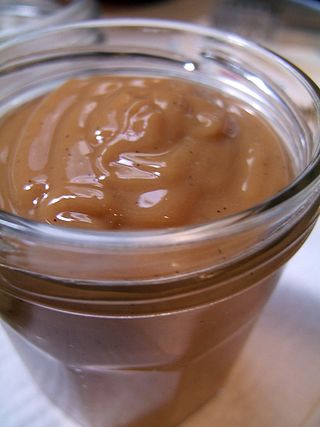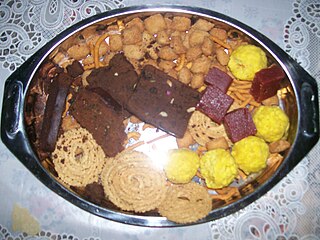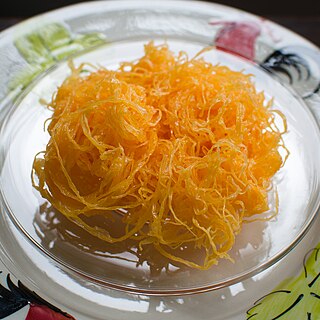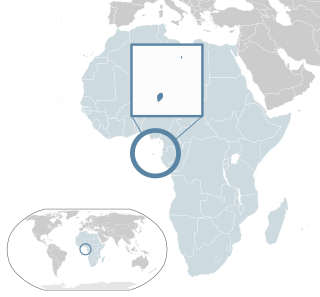
Brazilian cuisine is the set of cooking practices and traditions of Brazil, and is characterized by European, Amerindian, African, and Asian influences. It varies greatly by region, reflecting the country's mix of native and immigrant populations, and its continental size as well. This has created a national cuisine marked by the preservation of regional differences.

Dulce de leche, caramelized milk, manjar, milk candy or milk jam is a confection popular in Latin America, France, Poland and Philippines prepared by slowly heating sugar and milk over a period of several hours. The resulting substance, which takes on a spreadable, sauce-like consistency, derives its rich flavour and colour from non-enzymatic browning. It is typically used to top or fill other sweet foods.

Portuguese sweet bread refers to an enriched sweet bread or yeasted cake originating from Portugal. Historically, these sweet breads were generally reserved for festive occasions such as Easter or Pentecost and were typically given as gifts. However, in contemporary times, many varieties are made and consumed year round. Outside of Portugal, Portuguese "sweet bread" transliterated as "pão doce" is often associated with Azorean "massa sovada" which are similar but traditionally prepared differently.

Pingo Doce is one of the largest supermarket operators in Portugal, with almost 400 stores.

Sarapatel, or Sorpotel, is a dish of Portuguese origin now commonly cooked in the Konkan—primarily Goa, Mangalore, and Bombay—the erstwhile Estado da Índia Portuguesa colony. It is also prepared in northeastern Brazil. The word ‘Sarapatel’ literally means confusion, referring to the mish-mash of ingredients which include Pork meat and offal. However, in modern-day version, blood is rarely used as now getting the pure blood is slightly difficult. The meat is first parboiled, then diced and sauteed before being cooked in a spicy and vinegary sauce.

Doce was a Portuguese female band from the 1980s. It was one of the first girl bands in Europe.
Goan cuisine consists of regional foods popular in Goa, an Indian state located along India's west coast on the shore of the Arabian Sea. Rice, seafood, coconut, vegetables, meat, bread, pork and local spices are some of the main ingredients in Goan cuisine. Use of kokum and vinegar is another distinct feature. Goan food is considered incomplete without fish.

Kuswar or Kuswad is a set of festive sweets and snacks made and exchanged by Christians of the Konkan region in the Indian subcontinent for the Christmas season or Christmastide. These goodies are major parts of the cuisines of the Goan Catholic community of Goa in the Konkan region, and the Mangalorean Catholic community of Karnataka. There are as many as 22 different ethnic recipes that form this distinct flavour of Christmas celebration in Goa and Mangalore. Kuswad is also made and exchanged by Karwari Catholics of Carnataca and the Kudali Catholics of Sindhudurg, in the Konkan division of Maharashtra.

Conselheiro Pena, formerly known as "Lajao", is located in the state of Minas Gerais, Brazil. This town of 20,000+ inhabitants, was formed alongside the "Rio Doce", or Sweet River.

Gujhia, also known as Gughara, Pedakiya, Purukiya, Karanji, Kajjikayalu, Somas, and Karjikayi, is a sweet, deep-fried pastry that is a popular dessert in the Indian subcontinent. This delicacy is made using either suji (semolina) or maida, which is stuffed with a mixture of sweetened khoa and dried fruits. The dumpling is then fried in ghee to give it a crispy texture.
Patoleo are stuffed turmeric leaf wraps, a dish which is mostly prepared on the western coast of India. The main stuffing is made from freshly shredded coconut, rice flour paste, and palm jaggery; and cooked by wrapping and steaming in turmeric leaves.
The Culture of Goan Catholics is a blend of Portuguese and Konkani cultures, with the former having a more dominant role because the Portuguese ruled Goa directly from 1510 to 1961.

Goan Catholic Cuisine is the cuisine of the Goan Catholic community and is largely influenced by Portuguese cuisine. Due to over 450 years of Portuguese rule, the cuisine of Goan Catholics is dominated by ingredients and techniques of Portuguese cuisine like deep-frying, oven-baking, pork, vinegar, egg-based desserts, alcohol, etc.

A sanna is a spongy, steamed, and savoury unfilled dumpling originally made of red rice, black lentil and coconut in the Konkan region, by the western coast of the Indian subcontinent. They originated in Goa and Damaon, Mangalore, Bombay and Bassein (Vasai), and are especially popular among Goans, both the Goan Hindus and Goan Christians, and also among the Konkani migrants outside Konkan in Karachi, Sindh, Gujarat, Karnataka and Kerala. They are also loved by the people of the Konkan division, such as the Kuparis of the Bombay East Indian community.

Fios de ovos is a traditional Portuguese sweet food made of eggs, drawn into thin strands and boiled in sugar syrup. They can be found in many Thai desserts, this unique dish found its way to Thailand in the 17th century. It is a traditional element in Portuguese and Brazilian cuisine, both in desserts and as side dishes.

Santomean cuisine comprises the cuisine, dishes and foods of São Tomé and Príncipe, a Portuguese-speaking island nation in the Gulf of Guinea, off the western equatorial coast of Central Africa. The country consists of two archipelagos around the two main islands: São Tomé and Príncipe, located about 140 kilometres (87 mi) apart and about 250 and 225 kilometres, respectively, off the northwestern coast of Gabon.
Canja de Goa is a typical soup of the Indo-Portuguese cuisine of Goa, Daman and Diu, which once formed part of the Portuguese India, and is inspired by Portuguese soup.
Minha Doce Namorada is a Brazilian telenovela produced and broadcast by TV Globo. It premiered on 19 April 1971 and ended on 21 January 1972, with a total of 242 episodes. It's the ninth "novela das sete" to be aired at the timeslot. It is created by Vicente Sesso and directed by Régis Cardoso.












